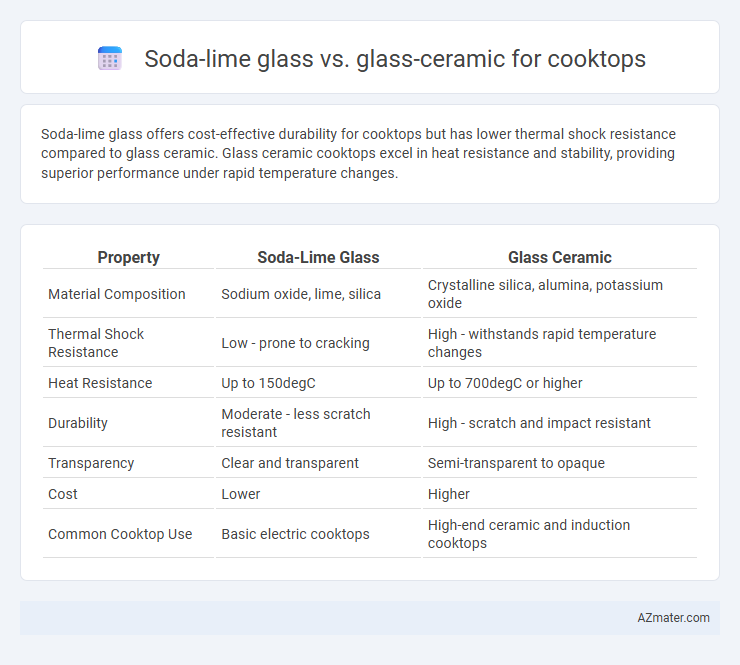Soda-lime glass offers cost-effective durability for cooktops but has lower thermal shock resistance compared to glass ceramic. Glass ceramic cooktops excel in heat resistance and stability, providing superior performance under rapid temperature changes.
Table of Comparison
| Property | Soda-Lime Glass | Glass Ceramic |
|---|---|---|
| Material Composition | Sodium oxide, lime, silica | Crystalline silica, alumina, potassium oxide |
| Thermal Shock Resistance | Low - prone to cracking | High - withstands rapid temperature changes |
| Heat Resistance | Up to 150degC | Up to 700degC or higher |
| Durability | Moderate - less scratch resistant | High - scratch and impact resistant |
| Transparency | Clear and transparent | Semi-transparent to opaque |
| Cost | Lower | Higher |
| Common Cooktop Use | Basic electric cooktops | High-end ceramic and induction cooktops |
Introduction to Cooktop Glass Materials
Soda-lime glass is the most common cooktop material known for its affordability and basic heat resistance, but it is prone to thermal shock and scratches. Glass ceramic cooktops utilize a crystalline structure that offers superior heat tolerance, preventing cracks under rapid temperature changes and enabling more efficient heat transfer. Choosing between soda-lime glass and glass ceramic depends on desired durability, heat performance, and budget considerations for cooktop surfaces.
What is Soda-Lime Glass?
Soda-lime glass is the most common type of glass used in cooktops due to its affordability and thermal stability. Composed primarily of silica (SiO2), sodium oxide (Na2O), and lime (CaO), this glass offers good heat resistance but is more prone to thermal shock compared to glass ceramics. Glass ceramic cooktops, in contrast, combine glass and crystalline materials to provide superior heat resistance and durability, making them less likely to crack under rapid temperature changes.
Understanding Glass Ceramic
Glass ceramic cooktops offer superior thermal shock resistance compared to soda-lime glass, allowing rapid temperature changes without cracking. Their low thermal expansion coefficient and high durability make them ideal for stovetop applications, enhancing safety and longevity. Unlike soda-lime glass, glass ceramics maintain structural integrity under intense heat, providing efficient heat conduction and energy use for cooking.
Key Differences Between Soda-Lime Glass and Glass Ceramic
Soda-lime glass, commonly used in cookware, offers affordability and moderate thermal resistance but is prone to cracking under rapid temperature changes. Glass ceramic, engineered for high thermal shock resistance, provides superior durability and can withstand direct contact with heat sources like cooktops without damage. The key difference lies in glass ceramic's crystalline structure, enabling it to endure extreme temperatures and sudden fluctuations, making it ideal for cooktop surfaces compared to traditional soda-lime glass.
Heat Resistance Comparison
Soda-lime glass cooktops typically withstand temperatures up to 600degF (316degC) before risk of thermal damage, whereas glass ceramic cooktops can endure temperatures exceeding 1200degF (649degC), making them significantly more heat resistant. Glass ceramics demonstrate superior thermal shock resistance due to their low thermal expansion coefficient, reducing the likelihood of cracking under rapid temperature changes compared to soda-lime glass. This enhanced heat tolerance and durability make glass ceramic the preferred material for high-performance cooktops in both residential and professional kitchens.
Durability and Strength Analysis
Soda-lime glass, commonly used in cooktops, offers moderate durability but is prone to scratches and thermal shock compared to glass-ceramic materials. Glass-ceramic cooktops exhibit superior strength due to their crystalline structure, providing enhanced resistance to heat, impact, and thermal stress. This makes glass-ceramic the preferred choice for high-performance cooktops requiring long-term durability and stability under rapid temperature changes.
Thermal Shock Performance
Soda-lime glass cooktops have moderate thermal shock resistance, making them susceptible to cracking under sudden temperature changes. Glass ceramic cooktops excel in thermal shock performance due to their low thermal expansion coefficient, allowing them to withstand rapid temperature fluctuations without damage. This superior thermal shock resistance makes glass ceramic an ideal choice for high-performance and durable cooktop surfaces.
Aesthetics and Design Flexibility
Soda-lime glass offers a sleek, glossy finish with limited color and pattern options, making it ideal for minimalist cooktop designs. Glass ceramic provides greater design flexibility with a variety of textures, colors, and customizable patterns, allowing for more intricate and visually striking cooktop surfaces. Its heat resistance also enables seamless integration of cooktops with varied aesthetic elements without compromising durability.
Cost Implications
Soda-lime glass cooktops generally offer a lower initial cost compared to glass ceramic cooktops, making them a budget-friendly option for many households. Glass ceramic cooktops, while more expensive upfront, provide enhanced durability and thermal resistance, which can reduce long-term replacement and maintenance costs. The improved heat tolerance of glass ceramic also supports energy efficiency during cooking, potentially lowering utility expenses over time.
Which Material is Best for Your Cooktop?
Soda-lime glass is widely used in cooktops for its affordability, good thermal resistance, and ease of manufacturing, making it a practical choice for everyday cooking. Glass ceramic, on the other hand, offers superior heat resistance, rapid thermal shock tolerance, and higher durability, which makes it ideal for high-performance cooktops and frequent heavy use. Choosing between soda-lime glass and glass ceramic depends on factors like budget, cooking style, and desired longevity, with glass ceramic often preferred for premium, long-lasting cooktop surfaces.

Infographic: Soda-lime glass vs Glass ceramic for Cooktop
 azmater.com
azmater.com